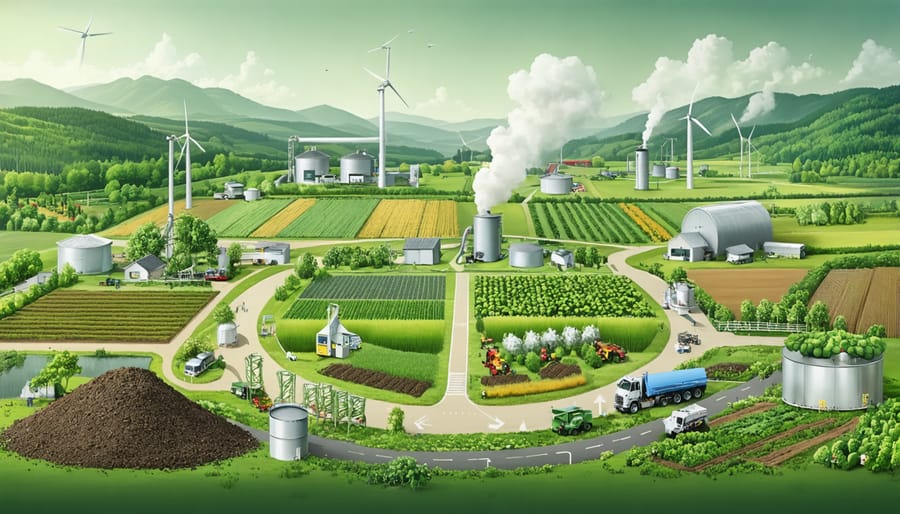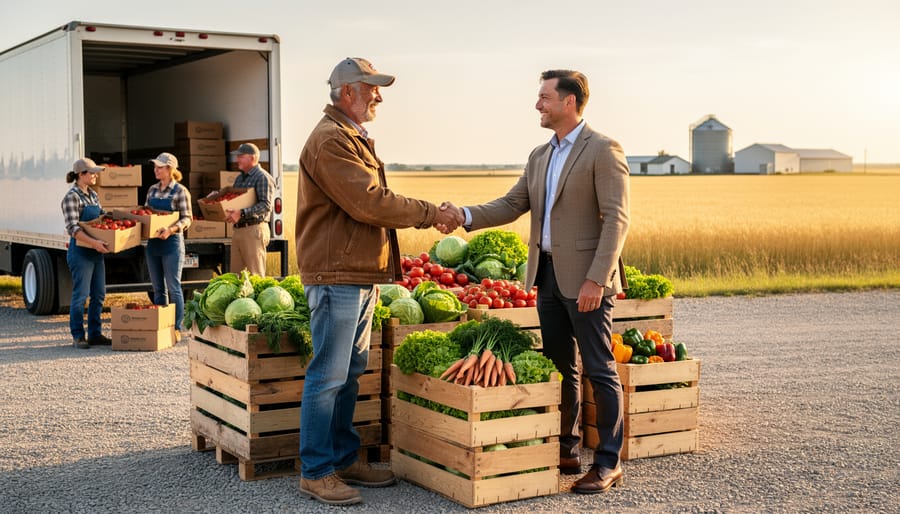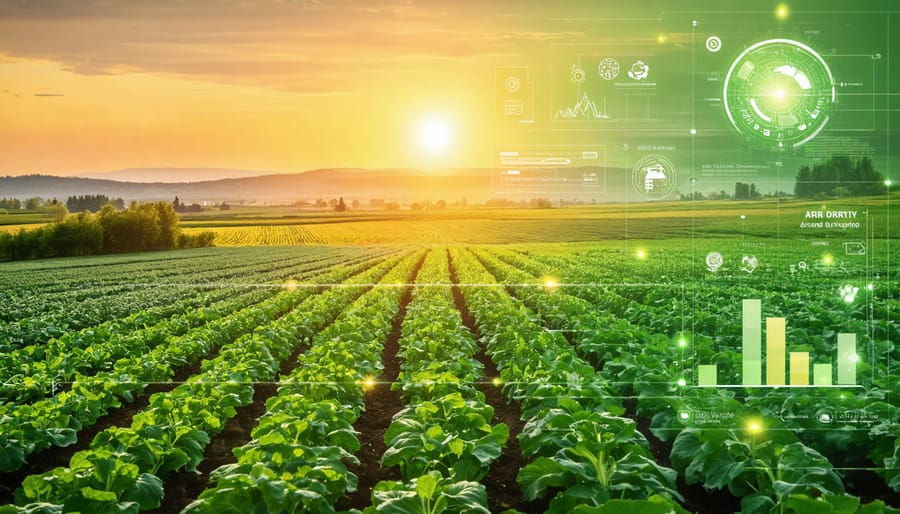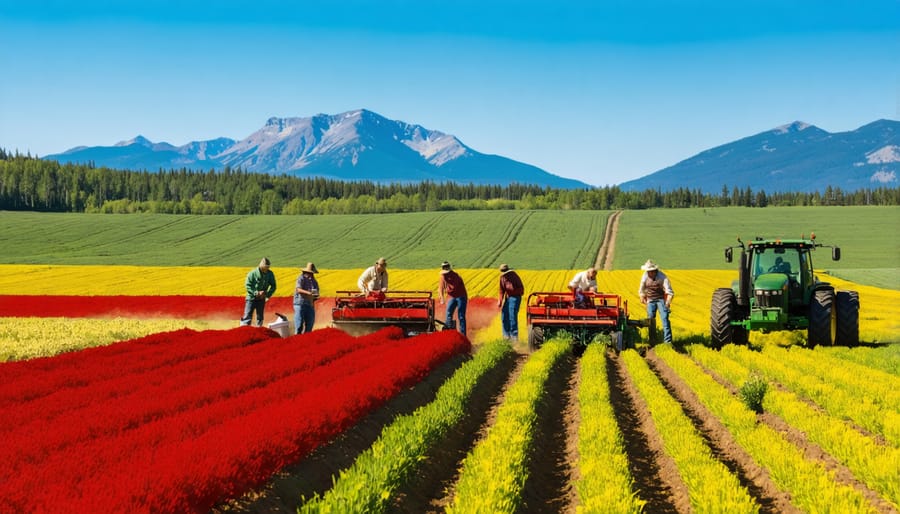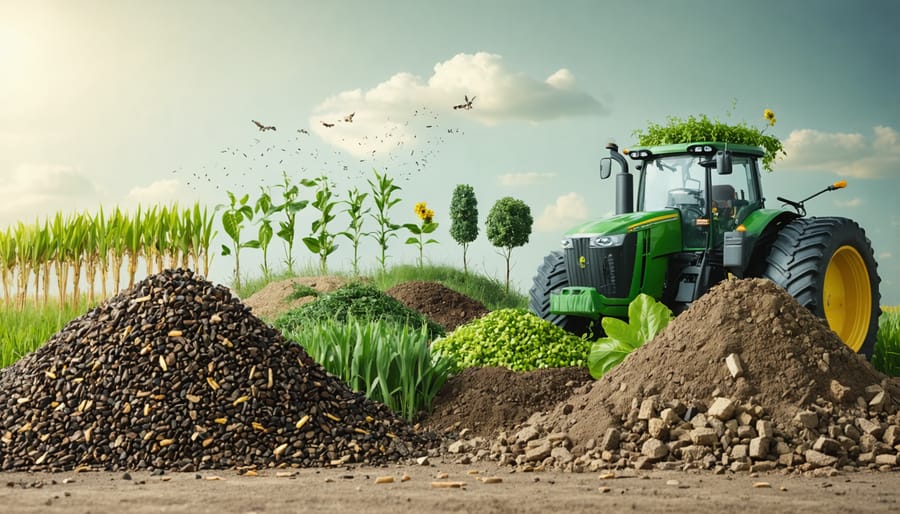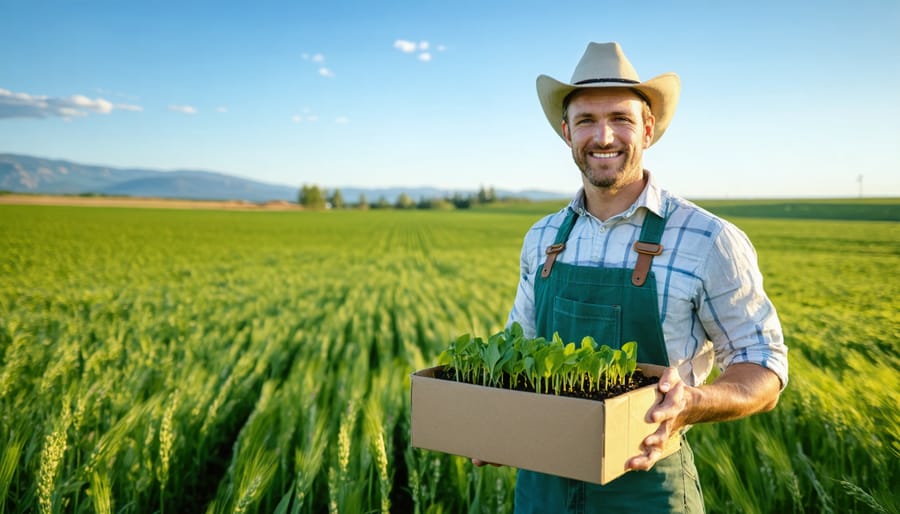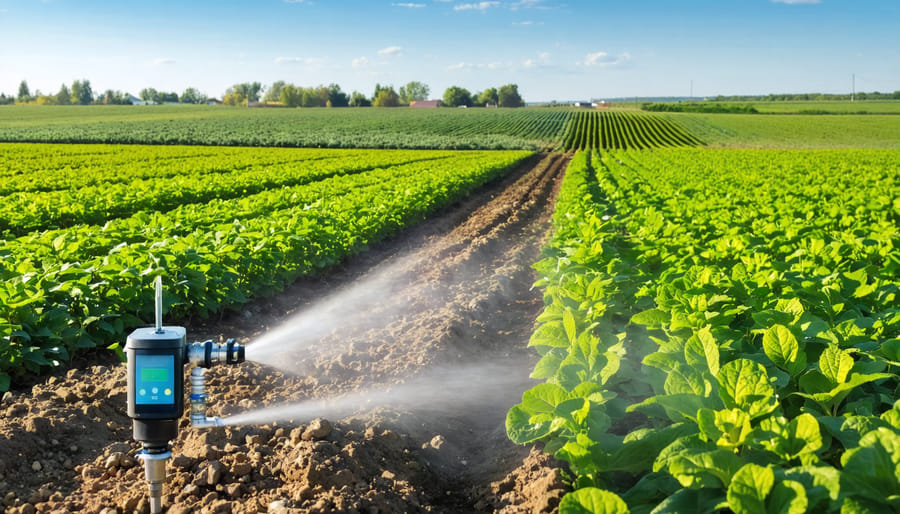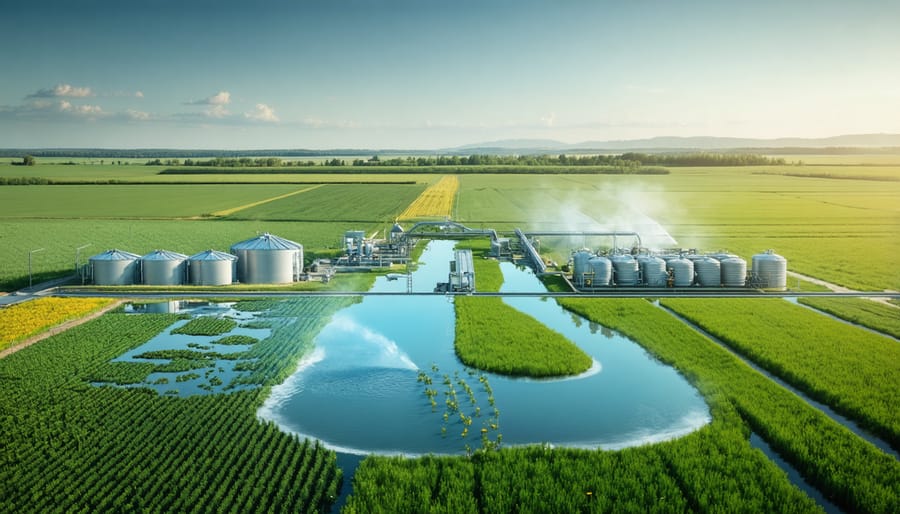Reimagine agricultural waste as valuable resources by implementing closed-loop systems that are transforming Canadian farm supply chains. Track and optimize material flows through digital monitoring systems, capturing data from seed to sale while identifying opportunities for waste reduction and resource recovery. Convert organic by-products into soil amendments, bioenergy, or value-added products through partnerships with local processors and manufacturers. Design packaging and transportation solutions that prioritize reusable containers, reverse logistics, and regional distribution networks, reducing both environmental impact and operating costs.
Alberta’s agricultural sector demonstrates how circular supply chains create resilient food systems that benefit both farm profitability and environmental stewardship. By closing resource loops, farms reduce input costs by up to 40% while developing new revenue streams from previously discarded materials. This regenerative approach positions Canadian agriculture at the forefront of sustainable innovation, building competitive advantage through resource efficiency and waste elimination.
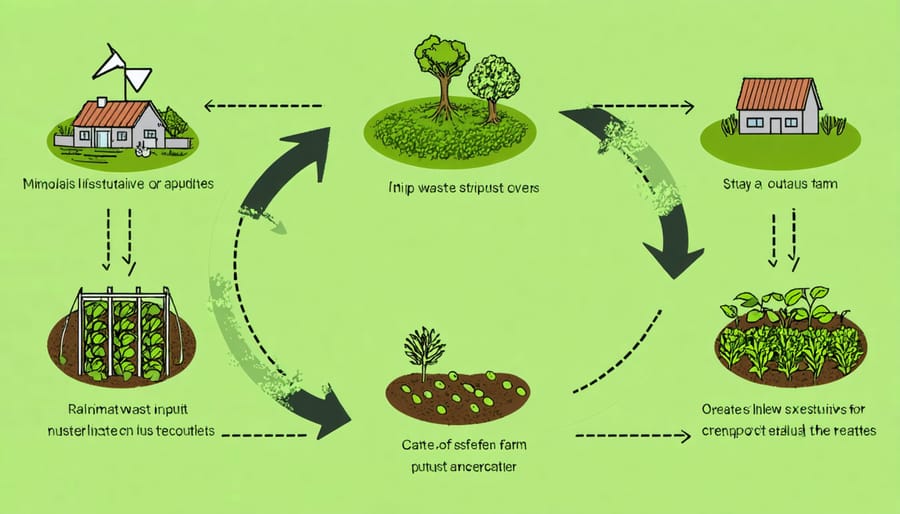
The Power of Circular Supply Chains in Alberta Agriculture
From Farm Waste to Farm Wealth
Alberta farmers are leading the way in transforming agricultural waste into valuable resources, demonstrating how sustainable energy practices can benefit both the environment and bottom line. The Lethbridge Biogas facility, for instance, converts over 100,000 tonnes of agricultural waste annually into renewable energy, powering approximately 2,800 homes while providing farmers with additional revenue streams.
In Red Deer County, the Morrison family farm has implemented an innovative composting system that processes crop residues and livestock manure into premium organic fertilizer. This initiative has reduced their chemical fertilizer costs by 40% while improving soil health across their 800-hectare operation.
Another success story comes from Lacombe, where a collective of grain farmers has developed a straw-recovery program that supplies material to local mushroom growers and livestock bedding manufacturers. This collaboration has created new market opportunities while addressing waste management challenges, generating an additional $15,000 in annual revenue per participating farm.
These examples showcase how Alberta’s agricultural community is turning waste challenges into profitable opportunities through innovative thinking and community collaboration.
Building Resilient Local Networks
Building strong local networks is vital for creating resilient circular supply chains in Alberta’s agricultural sector. By partnering with nearby farms, processors, and distributors, you can establish mutually beneficial relationships that reduce waste and maximize resource efficiency.
Take inspiration from the Olds-Didsbury Agricultural Loop, where twelve farms collaborate to share equipment, exchange by-products, and create closed-loop systems. One farm’s livestock manure becomes another’s organic fertilizer, while crop residues feed neighbouring cattle operations. This network has helped participants reduce input costs by 25% while improving soil health and reducing waste.
Consider joining or establishing a local agricultural co-op to share resources and knowledge. The Leduc Food Processing Centre offers excellent opportunities for farmers to connect with food processors and explore value-added possibilities for what might otherwise become waste products.
Start small by identifying potential partners within a 50-kilometre radius of your operation. Focus on complementary businesses where your outputs could become their inputs. Regular community meetings and agricultural events are great places to build these connections and explore collaborative opportunities.
Practical Implementation Steps
Assessment and Planning
To effectively implement circular supply chain practices on your farm, start by conducting a thorough assessment of your current operations. Begin with a resource mapping exercise, documenting all inputs, outputs, and potential waste streams. This includes tracking water usage, energy consumption, feed purchases, and crop residues across your operation.
Many Alberta farmers find success using the “Farm Sustainability Assessment Tool,” which helps identify opportunities for circular practices. This simple checklist approach evaluates key areas like waste management, resource efficiency, and potential value-added opportunities.
Consider these practical assessment steps:
– Track material flows through your operation for one production cycle
– Document current waste management practices and costs
– List potential partners within 100 kilometres for resource sharing
– Identify seasonal patterns in resource availability and demand
When planning for circularity, start small and scale up gradually. For example, the Morrison family farm near Red Deer began by composting crop residues and now operates a full-scale organic waste processing facility serving neighbouring farms.
Set clear, measurable goals for your circular initiatives. This might include reducing feed costs by 15% through local partnerships or cutting waste disposal expenses by 20% in the first year. Regular monitoring and adjustment of these goals ensures your circular strategy remains practical and profitable.
Remember to engage with local agricultural extension services and farmer networks – they often have valuable assessment tools and planning resources specifically designed for Canadian agricultural operations.
Resource Recovery Systems
Effective resource recovery systems are the backbone of circular supply chain management in Canadian agriculture. Here in Alberta, we’re seeing innovative approaches to collecting and processing agricultural waste that create value while reducing environmental impact.
Many local farms are implementing three-stream waste sorting systems, separating organic materials, recyclables, and specialized agricultural waste like chemical containers and twine. For example, the Mountain View County Agricultural Services Board has established a successful collection program that processes over 50,000 kilograms of agricultural plastics annually.
Smart technology integration plays a crucial role in modern recovery systems. GPS-enabled collection routes optimize pickup schedules, while automated sorting facilities ensure maximum resource recovery. These systems work alongside renewable energy integration to create truly sustainable operations.
Local success stories include the Lethbridge Biogas facility, which converts agricultural waste into clean energy and nutrient-rich fertilizer. This facility processes over 100,000 tonnes of organic waste yearly, demonstrating how recovery systems can transform waste into valuable resources.
To implement effective recovery systems on your farm, start by:
– Conducting a waste audit to identify major waste streams
– Setting up clearly marked collection points
– Training staff on proper sorting procedures
– Partnering with local recycling facilities
– Tracking and measuring recovery rates
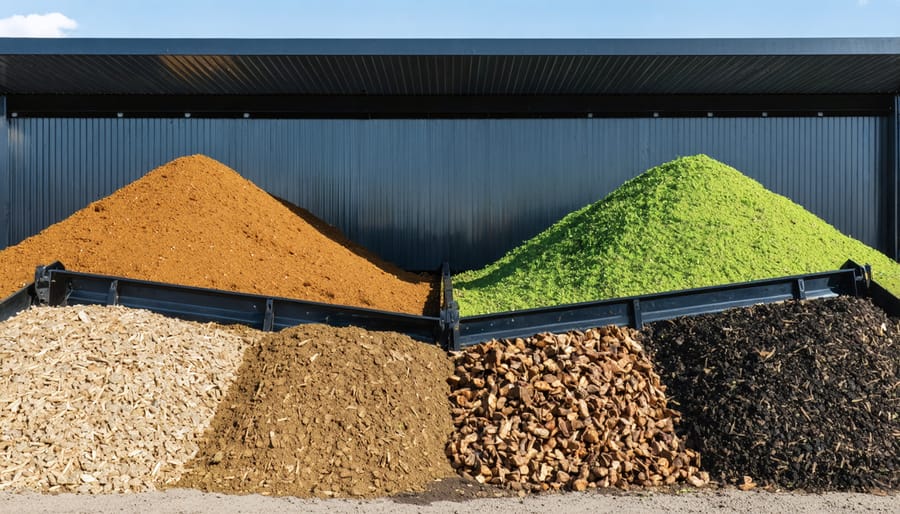
Partner Collaboration
Building strong partnerships is essential for success in circular supply chain management, and Alberta’s agricultural community offers numerous examples of effective collaboration. Local farmers have found that working together with neighbouring operations creates opportunities for sharing resources, reducing waste, and maximizing efficiency.
For example, the Southern Alberta Grain Exchange Network demonstrates how partnerships can work effectively. Through this initiative, farmers coordinate their grain storage and transportation needs, sharing equipment and logistics costs while reducing empty truck returns by up to 40%.
When developing partnerships, consider these proven strategies:
– Start with clear communication about goals and expectations
– Establish formal agreements that outline responsibilities and benefits
– Create regular check-in points to evaluate progress
– Share data and insights to improve collective outcomes
– Build flexibility into arrangements to accommodate seasonal changes
Many Alberta farmers have found success by partnering with local food processors to create closed-loop systems. Crop residues from one operation become valuable inputs for another, while processing by-products return to farms as organic amendments. The Lethbridge Food Recovery Initiative showcases how these partnerships can reduce waste while generating additional revenue streams.
Remember that successful partnerships often start small and grow gradually. Begin by identifying potential partners within a 50-kilometre radius of your operation, focusing on complementary businesses that share your commitment to sustainability and circular practices.
Real Success Stories from Alberta Farms
The Thompson Family Farm Revolution
Located just outside of Olds, Alberta, the Thompson Family Farm has become a shining example of circular supply chain management in action. In 2018, John and Sarah Thompson made the bold decision to transform their 800-hectare mixed farming operation into a closed-loop system, focusing on waste reduction and resource optimization.
The Thompsons began by implementing an innovative composting system that converts crop residues and livestock manure into nutrient-rich soil amendments. This eliminated their need for synthetic fertilizers while reducing waste disposal costs by 60%. They also introduced a rotational grazing system where cattle help manage crop residues and naturally fertilize fields, creating a symbiotic relationship between their livestock and crop production.
Working with local partners, the Thompsons established a biogas facility that transforms organic waste into energy, powering their farm operations and reducing their carbon footprint by 40%. They’ve also partnered with nearby farms to share resources and equipment, creating a local circular economy that benefits the entire community.
The results have been remarkable. Within three years, the Thompsons reduced their input costs by 35%, increased soil organic matter by 2%, and improved their overall farm profitability by 25%. Their success has inspired other Alberta farmers to adopt similar practices, demonstrating that circular supply chain management isn’t just environmentally responsible – it’s also good business.
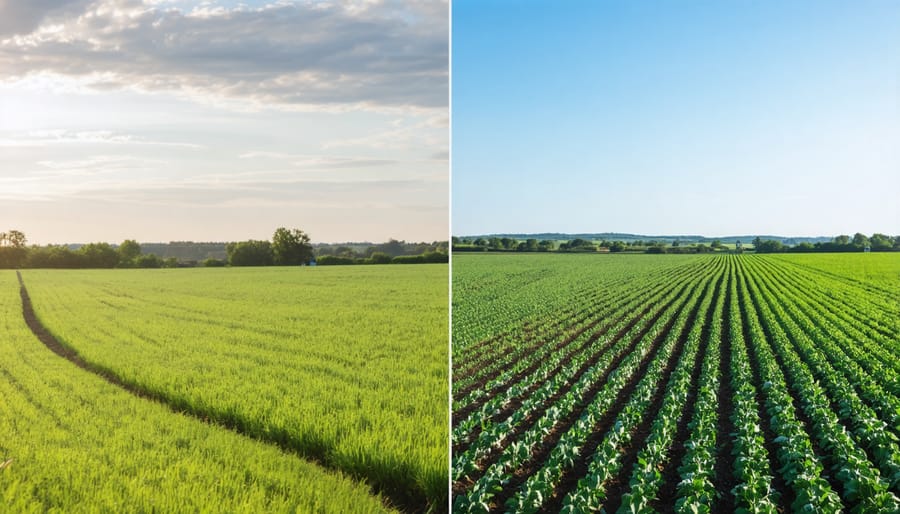
Cooperative Success in Red Deer County
In the heart of central Alberta, a group of five family farms in Red Deer County has pioneered a remarkable cooperative circular system that’s transforming local agricultural practices. Starting in 2019, these farms, ranging from 320 to 800 hectares each, collaborated to create an integrated network that maximizes resource efficiency and minimizes waste.
The system begins with the Larson family’s grain operation, which supplies feed and straw to the neighbouring Thomson cattle farm. The Thomson’s cattle manure is then processed in Miller Farm’s biodigester facility, producing both fertilizer and biogas. The fertilizer supports Peterson’s vegetable greenhouse operations, while the biogas powers both the greenhouse and Wright’s dairy facility.
The dairy operation completes the circle by providing liquid waste for composting, which returns to the grain fields, and whey byproducts that supplement the cattle feed at Thomson’s farm. This interconnected system has reduced input costs by 35% across all participating farms and decreased waste output by approximately 80%.
“What makes this work is trust and proximity,” explains Sarah Thomson, second-generation farmer. “We’re all within 15 kilometers of each other, which keeps transportation costs low and makes daily cooperation practical.”
The success has inspired three more local farms to join the network in 2023, expanding the system’s capacity and demonstrating the scalability of cooperative circular agriculture in the region.
Measuring and Maximizing Your Impact
Key Performance Indicators
In measuring the success of circular supply chain practices, Alberta farmers focus on several key performance indicators (KPIs) that reflect both environmental and economic impacts. Resource recovery rate tracks the percentage of materials successfully reused or recycled, with leading operations achieving rates above 80%. Waste reduction metrics measure the decrease in landfill-bound materials, typically targeting a 50% reduction within the first year of implementation.
Energy efficiency is another crucial indicator, with farms implementing energy-efficient farming solutions reporting up to 40% lower utility costs. Water conservation metrics track reduced consumption, with successful operations often achieving 30-45% savings through recycling and smart irrigation systems.
Financial KPIs include cost savings from reduced input purchases, revenue from byproduct sales, and return on investment for circular initiatives. Transportation efficiency metrics measure reduced fuel consumption and optimized delivery routes, while supplier engagement scores reflect the percentage of partners participating in circular practices. These indicators help farmers track progress and identify areas for improvement in their circular supply chain journey.
Continuous Improvement Strategies
In Alberta’s agricultural sector, continuous improvement is vital for maintaining effective circular supply chain systems. Regular monitoring and data collection help farmers track resource efficiency, waste reduction, and overall system performance. Many successful farmers in the region conduct quarterly assessments of their operations, measuring key metrics like water usage, soil health, and waste diversion rates.
Setting clear, achievable goals is essential. For example, the Morrison Family Farm in Lacombe reduced their organic waste by 35% over two years by implementing a structured improvement plan with monthly milestones. They started by identifying specific areas for enhancement and gradually introduced new practices, allowing time for adjustment and learning.
Engaging with local farming networks and participating in knowledge-sharing sessions can provide valuable insights for improvement. The Alberta Circular Agriculture Network hosts monthly meetups where farmers exchange best practices and discuss innovative solutions. Regular staff training and updates on new sustainable practices ensure everyone involved understands their role in maintaining the circular system.
Remember to remain flexible and open to adaptation as new technologies and methods emerge. What works today might need adjustment tomorrow as climate conditions and market demands evolve.
As we’ve explored throughout this article, circular supply chain management offers tremendous potential for Canadian agriculture, particularly here in Alberta. By embracing these sustainable practices, we can significantly reduce waste, maximize resource efficiency, and create more resilient farming operations that benefit both our environment and bottom line.
The success stories we’ve shared from local farmers demonstrate that transitioning to circular practices isn’t just theoretical – it’s already working in our communities. From implementing composting systems that turn agricultural waste into valuable soil amendments, to establishing local partnerships that create closed-loop supply networks, Alberta farmers are leading the way in sustainable agriculture.
Remember, you don’t need to transform your entire operation overnight. Start with small, manageable changes like conducting a waste audit or identifying potential circular partnerships in your area. Connect with local agricultural extension offices and farmer networks who can provide guidance and support as you begin this journey.
The future of Canadian agriculture depends on our ability to adapt and innovate. By incorporating circular supply chain principles into your farming operations, you’re not just making a smart business decision – you’re contributing to a more sustainable future for Alberta’s agricultural sector.
Take that first step today. Whether it’s attending a workshop, reaching out to potential partners, or reviewing your current practices, every action moves us closer to a more circular and sustainable agricultural system.

